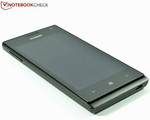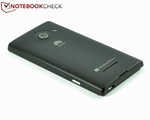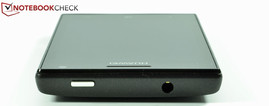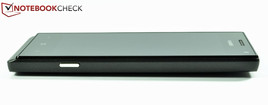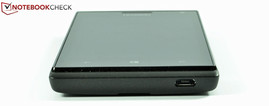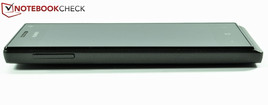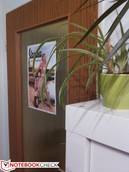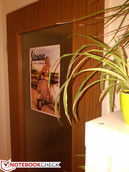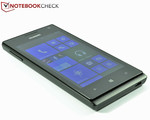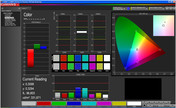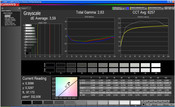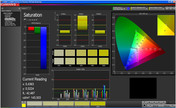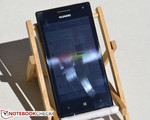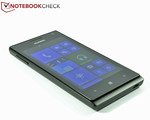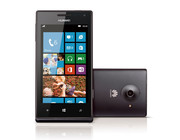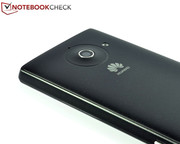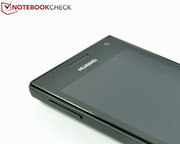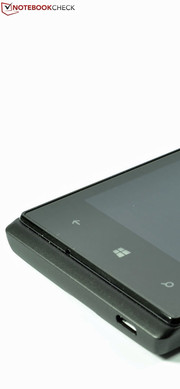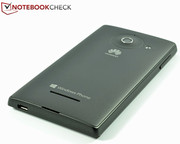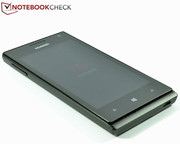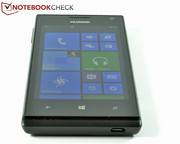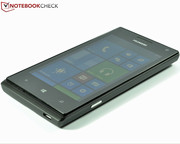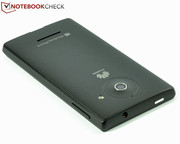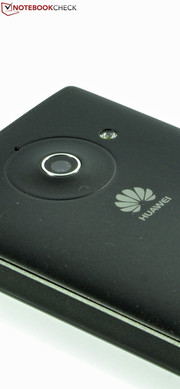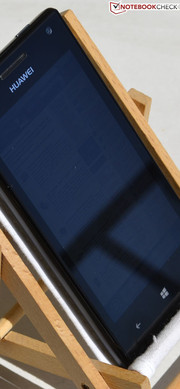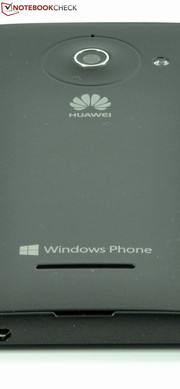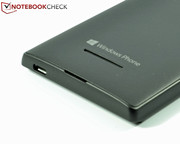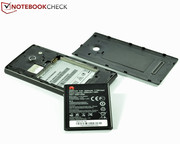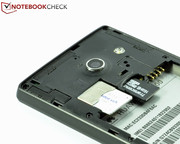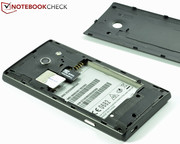Review Huawei Ascend W1 Smartphone
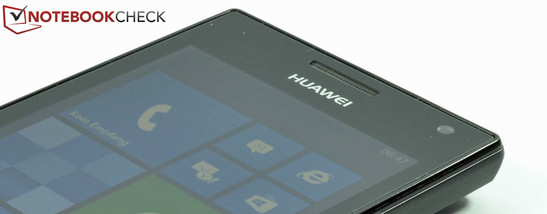
For the original German review, see here.
Until now Huawei has only launched smartphones powered by an Android operating system under the model range Ascend. We last reviewed Huawei's Ascend Y300. With the Ascend W1, the overdue entry in the Windows Phone 8 sector finally takes place. The fact that the manufacturer, who has been active in Germany for over a decade, places its first Windows-based smartphone in the entry-range with an RRP of 219 Euros (~$283) shows some reluctance to accept the operating system from Redmond. However, our reviews of several Windows 8 devices prove that this is needless. For example, direct contenders are Nokia's Lumia 620 or even HTC's Windows Phone 8S. Huawei boldly touts the Ascend W1 with "Have fun Get things done". Our acid test shows what the 4-inch smartphone featuring a 1.2 GHz Qualcomm dual-core SoC and 4 GB of flash memory can really get things done.
Case
The Huawei Ascend W1's casing is comprised of matte-black polycarbonate that has a pleasant non-slip rubber coating. A glass pane dominates on the front. The device exhibits a unique design because a part of the casing protrudes at the lower edge. Compared with the Android models, the test device's design is more angular but that does not unduly spoil the feel. The rigidness is very good. The tightly fitted back cover and the display's glass do not dent visibly under high pressure. The build is of a high standard with even gaps.
The smartphone does not belong to the lightest and most compact of its kind with a size of 124.5 x 63.5 x 10.15 mm (~4.9 x 2.5 x 0.4 inches) and a weight of 125 g (~4.4 ounces) and is roughly on a par with its contenders. Its feel is nevertheless very pleasing. The back cover can be removed via a small recess in the lower back side. When opened, the user can access the removable 7.5 Wh battery, the SIM card slot and the micro SD card reader.
Connectivity
Our test device is powered by a Qualcomm Snapdragon S4 MSM8230 dual-core SoC with a clock rate of 1.2 GHz and 512 MB of RAM alongside the integrated Qualcomm Adreno 305 graphics card with a core rate of 400 MHz. The internal flash memory of only 4 GB is rather low, but can be expanded up to 32 GB via a micro SD slot. It is just too bad that the operating system does not allow storing apps on SD cards. Even more aggravating is the net capacity of just 2 GB.
The ports are also kept to a minimum. There is not more than the compulsory micro USB 2.0 port on the bottom edge and the 3.5 mm audio jack on the top on Huawei's Ascend W1.
Software
The intuitive Windows Phone 8 operating system alongside its clearly arranged tile interface is installed. Despite the budget price, Huawei also installs useful software. Microsoft Office Mobile ensures productivity on the go. SkyDrive automatically synchronizes changes in the background. Outlook ensures comprehensive email functionality. Unfortunately, there is no navigation software like in Nokia's Lumia 620.
Communication & GPS
Huawei's Ascend W1 connects to wireless networks via an integrated Wi-Fi b/g/n and UMTS module. Bluetooth 2.1 for short-range data sharing is also available. The reception was consistently perfect in the test, even when a distance of 10 meters (~33 feet) and several walls stood between the router and smartphone.
The installed GPS module exhibited an equally stable and reliable signal strength.
Telephony
The telephone app corresponds to the Windows Phone 8 standard and offers a clear arrangement and intuitive user interface.
Cameras & Multimedia
Huawei's Ascend W1 sports a front-facing webcam with a VGA resolution of 0.3 MP and a 5 megapixel primary camera. The latter also has autofocus and LED flash, which is also used as a video light for video recordings of at most 720p. However, the LED Flash gives pictures a much too warm hue that seems overly reddish. The front-facing camera is only suitable for video chats due to extreme noise and low resolution. In return, the primary camera makes quite decent pictures in good ambient light. Although they exhibit a slight image noise and lack the last ounce of focus, the performance is acceptable in view of the low price.
Accessories
Besides the smartphone, Huawei supplies a compact power supply, quick start guide and a standard stereo headset. The manufacturer currently does not have more accessories in its product range.
Warranty
Huawei includes a 24-month warranty on the Ascend W1. The battery and charger are only covered for 6 months and 3 months are given on the included headset. The manufacturer does not offer any warranty upgrades.
Input Devices & Controls
The virtual QWERTY keyboard layout is also Windows Phone 8 standard. The arrangement is good and the keys are big enough to type quickly and without errors after a while.
The touchscreen responds swiftly and without noticeable delays. The gliding resistance on the screen's glass surface is pleasant and the automatic screen rotation is smooth and reliable. Overall, the touchscreen enables a sufficiently fast workflow.
The soft-touch buttons below the screen respond just as reliably. The physical buttons, such as the power button, volume control and camera shutter release, all feature a clear pressure point and sufficiently long key drop, which give the user a decent feedback.
The screen in Huawei's Ascend W1 features an IPS LCD screen with OGS technology (one-glass solution; advantage: thinner build). As common for the price range, it has a resolution of 800x480 pixels (WVGA).
The average brightness of approximately 333 cd/m² together with an illumination of 95% and a top rate of 341 cd/m² places the screen in the upper midfield. HTC's Windows Phone 8S, for example, achieved around 331 cd/m² with an illumination of 88% and Samsung's ATIV S only managed 244 cd/m² with 90%. However, our test device is remote from the category-independent brightness marvel Nokia Lumia 620 that accomplished 502 cd/m² at 94%.
| |||||||||||||||||||||||||
Brightness Distribution: 95 %
Center on Battery: 338 cd/m²
Contrast: 663:1 (Black: 0.51 cd/m²)
The black value of 0.51 cd/m² leads to an average black reproduction in dark contents. The contrast of 663:1, which results from the black value and average brightness, is not as convincing. This particularly becomes evident when directly compared with the competition. Huawei's Ascend W1 clearly places itself behind Nokia's Lumia 620 with 936:1, HTC's Windows Phone 8S with 812:1 and Samsung's ATIV S with 11950:1. Only HTC's Windows Phone 8X is on an equally low level of 653:1.
The objective color assessment using CalMan 5 software and X-Rite i1Pro 2 colorimeter shows that red deviates from the ideal. In return, the green and blue color values are slightly overemphasized. However, the color reproduction is quite close to the ideal. The grayscale reproduction marginally drifts away from the ideal and we recorded a maximum DeltaE of 5 in medium hues, which is an acceptable rate. Only sensitive persons will notice color casts.
Subjectively, the pictures show saturated black and brilliant colors. Only the focus decreases slightly depending on the content, which is also due to the fairly low resolution. The reproduction only looks a bit pale in a direct comparison with other IPS screens.
Although the glass surface is innately very reflective when exposed to light, the average brightness of 332 cd/m² makes outdoor use possible.
Nevertheless, the brightness cannot completely outshine direct sunlight. It is however high enough to display contents quite legibly in the shade. An anti-glare screen protector from the third-party suppliers can help prevent annoying reflections.
The IPS screen's viewing angle stability is very high due to its technology. The brightness first decreases and colors deviate marginally in extreme, unrealistic viewing angles. We regrettably could not make screenshots due to a hardware defect, just before the end of the test.
Performance
We extensively dealt with the hardware configuration in Connectivity. The Qualcomm Snapdragon S4 MSM8230 with a clock rate of 1.2 GHz SoC (system-on-a-chip) only has a total of 512 MB working memory available. This is unfortunately not enough for the brand new Rightware DX Benchmark 2.7 that enables comparing Android and iOS devices. It requires at least 1 GB of RAM.
Therefore, we can only use the synthetic benchmark AnTuTu v0.8.0 beta. The test device fared quite well with a total score of 8640 points. For comparison, Huawei's Ascend W1 has a marginal lead on Nokia's Lumia 620 with 7469 points and HTC's Windows Phone 8S with 7332 points, both of which sport a slightly weaker SoC. The stronger contenders, HTC's Windows Phone 8X (12281 points) and Nokia's Lumia 820 (11644 points) as well as Samsung's ATIV S (12622 points) achieve a much higher score, but they are also much more expensive.
Thus, the focus of the tests is on browser-based benchmarks. Huawei's Ascend W1 can surpass both HTC's Windows Phone 8S and Nokia's Lumia 620 by an approximately 30% higher score in the Peacekeeper test. With 1675 points, it even excels Samsung's ATIV S and only lags marginally behind Nokia's Lumia 820 in Browsermark 2.0. The Sunspider 0.9.1 speed benchmark underlines this good performance with 1124.7 ms and the test device secures itself first place among its direct contenders.
| Sunspider - 0.9.1 Total Score (sort by value) | |
| Huawei Ascend W1 | |
| HTC Windows Phone 8X | |
| HTC Windows Phone 8S | |
| Nokia Lumia 620 | |
| Samsung ATIV S | |
| Nokia Lumia 820 | |
| Peacekeeper - --- (sort by value) | |
| Huawei Ascend W1 | |
| HTC Windows Phone 8S | |
| Nokia Lumia 620 | |
| Samsung ATIV S | |
| Nokia Lumia 820 | |
| Browsermark - --- (sort by value) | |
| Huawei Ascend W1 | |
| HTC Windows Phone 8S | |
| Nokia Lumia 620 | |
| Samsung ATIV S | |
| Nokia Lumia 820 | |
* ... smaller is better
The other browser benchmarks confirmed this leading position. Google's V8 benchmarks recorded an up to 25% lead over HTC's Windows Phone 8S and Nokia's Lumia 620 for Huawei's Ascend W1. The more expensive smartphone competition again has an average lead of 25%. Mozilla Kraken V1 and Google Octane V1 finish with a similar picture. Overall, Huawei's new Windows Phone 8 gives a very decent performance.
| Google V8 Ver. 7 - Google V8 Ver. 7 Score (sort by value) | |
| Huawei Ascend W1 | |
| HTC Windows Phone 8X | |
| HTC Windows Phone 8S | |
| Nokia Lumia 620 | |
| Samsung ATIV S | |
| Nokia Lumia 820 | |
| Google V8 Ver. 6 - --- (sort by value) | |
| Huawei Ascend W1 | |
| HTC Windows Phone 8X | |
| Samsung ATIV S | |
| Nokia Lumia 820 | |
| Google V8 Ver. 3 - --- (sort by value) | |
| Huawei Ascend W1 | |
| HTC Windows Phone 8X | |
| HTC Windows Phone 8S | |
| Samsung ATIV S | |
| Nokia Lumia 820 | |
| Octane V1 - Total Score (sort by value) | |
| Huawei Ascend W1 | |
| HTC Windows Phone 8S | |
| Samsung ATIV S | |
| Nokia Lumia 820 | |
| Mozilla Kraken 1.0 - Total (sort by value) | |
| Huawei Ascend W1 | |
| HTC Windows Phone 8S | |
| Samsung ATIV S | |
| Nokia Lumia 820 | |
* ... smaller is better
Games
Qualcomm's Adreno 305 graphics card is integrated into the SoC and clocks with 400 MHz. More information about the chip's specifications can be found on Qualcomm's website.
The hardware's performance suffices for the few games currently available in the Windows Store. No problems emerged in the tested games Angry Birds Star Wars, Plants vs. Zombies or Need for Speed: Hot Pursuit. The gameplay was always smooth.
Navigating via the touchscreen as well as the accelerometer and position sensor also worked flawlessly.
Due to the aforementioned screen defect shortly before the end of the tests, we regrettably cannot supply screenshots of the tested games.
Speech Quality
The audio quality during calls is decent at both ends. Regardless whether landline or mobile network, the called party confirmed good intelligibility and sufficiently high volume in several test calls.
Emissions
Speakers
The installed speaker provides an acceptable sound and is loud enough for calls using the hands-free feature. However, music enjoyment just does not evolve due to the artificial sound with restrained mids, tinny trebles and lack of bass support. The included in-ear stereo headset is not much better and should be replaced by a higher-quality alternative. Generally, the sound output via the 3.5 mm audio jack is very good and also sufficiently loud when required.
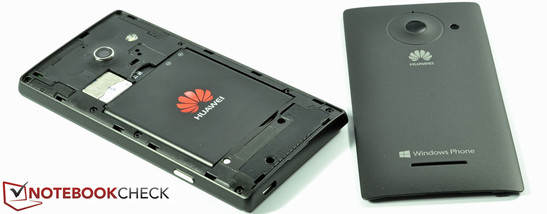
Temperature
We measure the surface temperatures in daily practical use with the Voltcraft IR-350. This tool recorded a moderate idle temperature development on Huawei's Ascend W1. A maximum of 29 °C (84.2 °F) was reached and the average temperature only added up to approximately 26 °C (78.8 °F).
The temperatures also only climbed to a maximum of 45.5 °C (113.9 °F) in the stress test. The test device's average surface temperature increased to a moderate 35.5 °C (95.9 °F). Here, the smartphone's GPU and CPU are pushed to the performance limits via the WP Bench app.
(±) The maximum temperature on the upper side is 42.4 °C / 108 F, compared to the average of 35 °C / 95 F, ranging from 21.9 to 56 °C for the class Smartphone.
(-) The bottom heats up to a maximum of 45.5 °C / 114 F, compared to the average of 33.8 °C / 93 F
(+) In idle usage, the average temperature for the upper side is 26.3 °C / 79 F, compared to the device average of 32.7 °C / 91 F.
Energy Management
Power Consumption
Huawei manages the Ascend W1's power consumption very well. It is particularly evident in the category comparison that the contenders consume much more power. For example, the test device is satisfied with an idle power consumption of 0.5 to 1.2 Watts. Nokia's Lumia 620 treats itself to as much as 1.2 to 2.2 Watts and HTC's Windows Phone 8S consumes an even higher 1.2 to 2.6 Watts.
This gap grows considerably during load. The Ascend W1 consumes an average of 1.5 Watts and a maximum of 2 Watts. HTC's Windows Phone 8S drains between 3.0 and 4.1 Watts, Nokia's Lumia 620 even needs 2.8 to 4.4 Watts. That is a significantly higher consumption considering their marginally weaker components. Nokia can only put this back in perspective with its overly bright screen.
| Off / Standby | |
| Idle | |
| Load |
|
Battery Runtime
Huawei's Ascend W1 does a very good job in this application. But that was to be expected in view of a 7.5 Wh battery with 1950 mAh alongside the low power consumption. Consequently, the test device easily surpasses the competition with a much smaller battery and higher power consumption.
The maximum battery runtime that we ascertained using our standard script in maximum brightness and with enabled energy saving mode was 18.5 hours. Nokia's Lumia 620 and HTC's Windows Phone 8S supply an approximately 4 and 3.5 hour shorter runtime here.
Our practical Wi-Fi browsing test, using medium brightness (158 cd/m²) resulted in an even more impressive 19 hours and 26 minutes. Here, different websites are automatically opened in turns. The contenders in form of HTC's Windows Phone 8S with 8:37 hours and Nokia's Lumia 620 with 10:15 hours are categorically crushed.
The minimum runtime in full load using maximum screen brightness is 2 hours and 36 minutes. Huawei's Ascend W1 is just behind HTC's Windows Phone 8S with 2:47 hours but lasts about half an hour longer than the other contenders.
Verdict
Huawei wants to mingle in the still new Windows Phone 8 market with its brand new Ascend W1. The manufacturer's debut is successful. The bright IPS screen is seldom seen in the 200 Euros (~$259) price range and contributes largely to the Ascend’s good impression. The above-average, long battery runtime and decent equipment wrapped up in an elegant design are also compelling. The power-duo from Qualcomm is strong enough for all applications and ensures swift routine use. The small working memory of only 512 MB is a minor bottleneck that may prevent running a few apps.
Consequently, we cannot give Huawei's Ascend W1 an unlimited purchase recommendation because this debut was not completely impeccable. Like almost all low-budget Windows phones, the test device suffers from the ridiculously small internal net storage capacity of only 2 GB. The well-meant micro SD interface only expands the storage capacity for multimedia files, but not for apps due to system-related reasons.
Buyers who can accept the cons and are looking for a decently equipped Windows Phone 8 smartphone for a good price of currently 185 Euros (~$239) can take this device. However, it should be carefully compared with Nokia's Lumia 620 and HTC's Windows Phone 8S beforehand.


 Deutsch
Deutsch English
English Español
Español Français
Français Italiano
Italiano Nederlands
Nederlands Polski
Polski Português
Português Русский
Русский Türkçe
Türkçe Svenska
Svenska Chinese
Chinese Magyar
Magyar